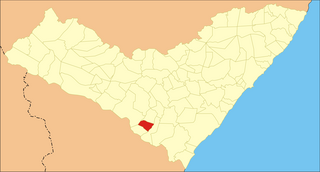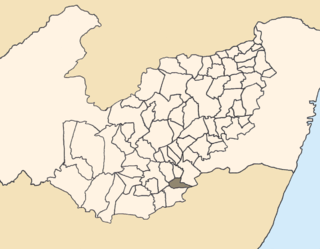
Alagoa is a city in the Brazilian state of Minas Gerais. In 2020 its population was estimated to be 2,665.

Coruripe is a municipality located in the southern coast of the Brazilian state of Alagoas. Its population is 57,294 (2020) and its area is 913 km2. It is the largest municipality in Alagoas by area, but among the largest municipalities of each Brazilian state, it is the smallest. It is situated at the edge of Coruripe river.

Cajueiro is a municipality located in the western of the Brazilian state of Alagoas. Its population is 21,331 (2020) and its area is 124 km². Its name comes from the Portuguese for the cashew tree — in the 19th century, a village began to form around such a tree, near the banks of the Paraíba river.
Coité do Noia is a municipality located in the center of the Brazilian state of Alagoas.
Estrela de Alagoas is a municipality located in the western of the Brazilian state of Alagoas. Its population is 18,255 (2020) and its area is 264 km².
Feliz Deserto is a municipality located in the south of the Brazilian state of Alagoas. Its population is 4,779 (2020) and its area is 92 km².
Igreja Nova is a municipality located in the south of the Brazilian state of Alagoas. Its population is 24,586 (2020) and its area is 429 km2.

Minador do Negrão is a municipality located in the Brazilian state of Alagoas. Its population is 5,322 (2020) and its area is 167 km².

Olho d'Água Grande is a municipality located in the Brazilian state of Alagoas. Its population is 5,128 (2020) and its area is 119 km².
Santana do Mundaú is a municipality located in the Brazilian state of Alagoas. Its population peaked at 11,235 in 2005 and was 10,687 in 2020. Its area is 224 square kilometres (86 sq mi).

São Brás is a municipality located in the Brazilian state of Alagoas. Its population was 6,969 (2020) and its area is 140 km².
São Sebastião is a municipality located in the Brazilian state of Alagoas. Its population was 34,290 (2020) and its area is 306 km2.
Tanque d'Arca is a municipality located in the center of the Brazilian state of Alagoas. In 2020, its population was 6,138. Its area is 156 km².
Taquarana is a municipality located in the center of the Brazilian state of Alagoas. Its population was 20,072 (2020) and its area is 166 km2.

The Pajeú River is a tributary of the São Francisco River in the state of Pernambuco in northeastern Brazil. The Pajeú originates on the Borborema Plateau, and flows 353 kilometres (219 mi) southwest to join the São Francisco. It has a total watershed of 16,685.63 square kilometres (6,442.36 sq mi), which represents 16.97% of the total area of the state of Pernambuco.

Bom Conselho is a city in northeastern Brazil, in the state of Pernambuco. It lies in the mesoregion of Agreste of Pernambuco and has 786.2 sq/km of total area.

Quipapá is a city located in the state of Pernambuco, Brazil. Located at 186 km away from Recife, capital of the state of Pernambuco. Has an estimated population of 26,175 inhabitants.

Canhotinho is a city located in the state of Pernambuco, Brazil. It is 223 km away from Recife, capital of the state of Pernambuco. Canhotinho has an estimated population of 24,773 inhabitants.

Correntes is a town located in the state of Pernambuco, Brazil. It is located 257.7 km (160.1 mi) away from Recife, the capital of the state of Pernambuco. It has an estimated population of 18,268 inhabitants.

Palmeirina is a city located in the state of Pernambuco, Brazil. Located 252 km from Recife, capital of the state of Pernambuco, Palmeirina has an estimated population of 7,600 inhabitants.











